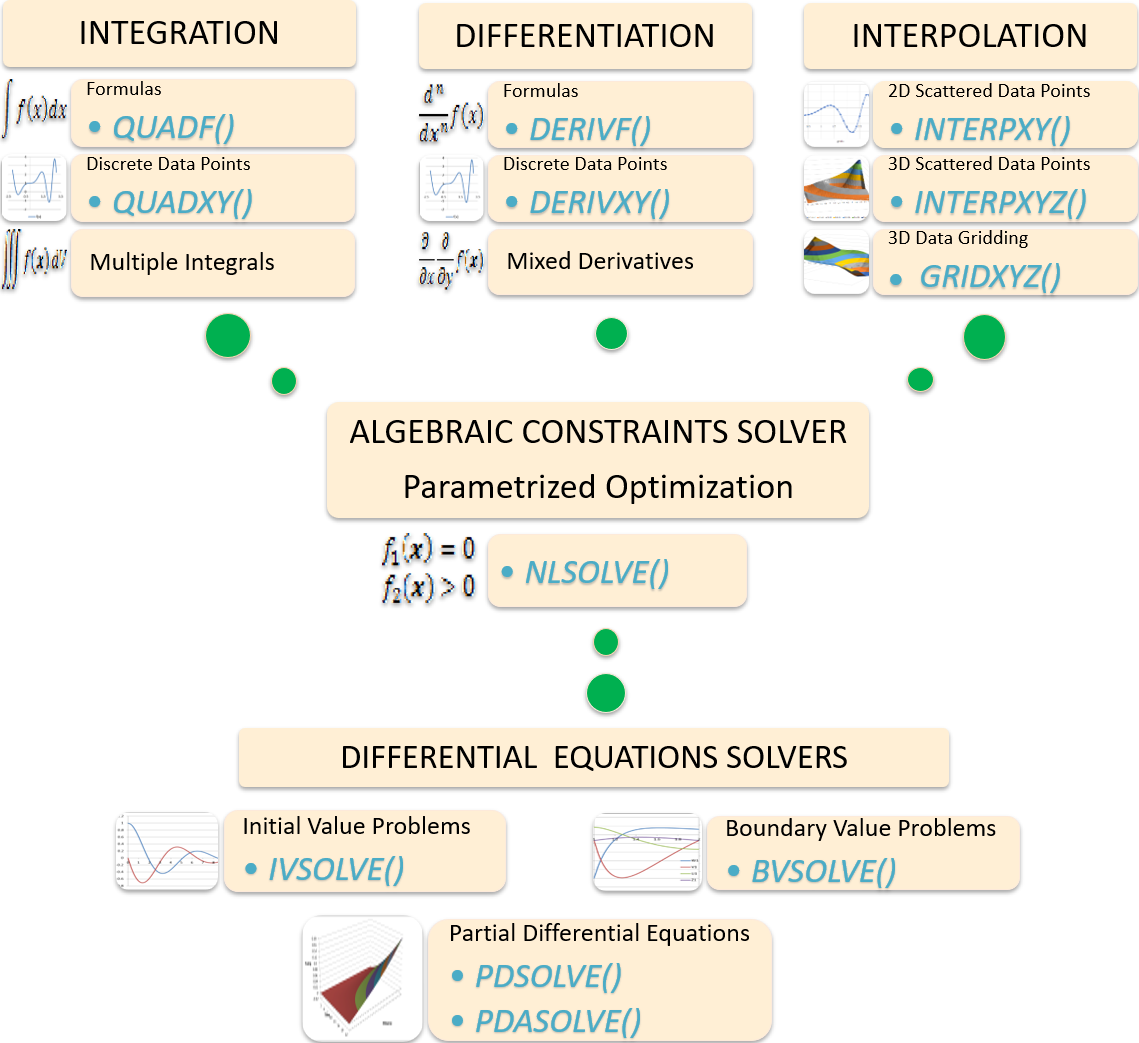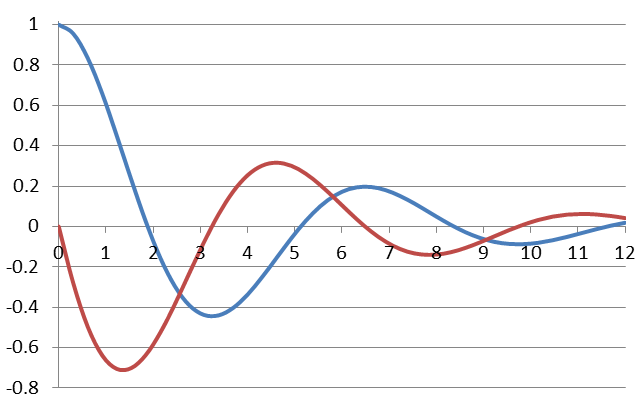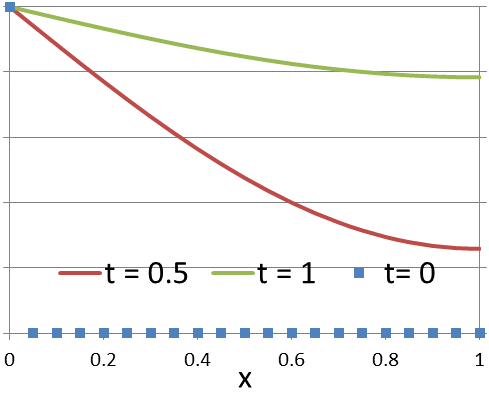 ExceLabTM 7.0
ExceLabTM 7.0
Calculus Functions Powerhouse Add-in
Patented Library of Calculus Spreadsheet solvers for Microsoft Excel and Google Sheets
For Windows PCs, Apple Macs and Online

ExceLab 365
Apple Mac; Office 365; Excel Online
In your Excel click Install → Get Add-ins
Microsoft 365 account is required
Solve complex calculus problems with simple formulas
✔Expand Excel/Sheets native math function with a super set of powerful solvers.
✔Use the solvers in standard formulas exactly like native math functions.
✔Runs on all localized Windows versions, Apple Macs and online
✔No coding. No learning curves. Just basic Excel spreadsheet skills.
✔Lightweight add in with superfast installation and you are up and running.
✔State of the art proven algorithms that work with superior performance.
✔Share your results workbook easily with your co-workers.
✔Evaluate free to your satisfaction.
✔Get prompt support and answers to questions from our experienced team.
What our users say
"Excelab 7.0 is perfect product, daily used very efficiently while saving unbelievable time in calculations and result analyzing."
"ExcelWorks calculus add-in has been incredibly helpful.... The ExcelWorks support have also been incredibly helpful, responding to any queries I had in a quick and effective manor. I would most definitely recommend this add-in to anyone considering."
".. the ability to share models and results in a highly familiar platform..with near-zero learning-curve in using the program, have compelled me to break from the past and put in the effort to move our models to ExceLab."
"It is easy to learn and support provided by the admin staff is very nice. If anyone working on multi PDEs equation problems, just try this one you will love this solver"
"I found excel-works derivative functions quite useful. I was particularly pleased with the prompt response for assistance when I required some technical issues to be resolved....."
Integration
Description
This video demonstrates how to use the integration functions QUADF for computing accurate integrals in both Excel and Google Sheets. Several examples are solved including fixed limits, infinite limits and singular points. The video also demonstrates how to nest QUADF to compute multiple integrals of any order.Description
This video demonstrates how to use the function QUADXY to compute accurate integral of a graph generated from discrete (x,y) data set points in both Excel and Google Sheets by the aid of splines.Differentiation
Description
This video demonstrates how to use the function DERIVF to compute first and higher order derivatives of any function in both Excel and Google Sheets. The video also demonstrates how to nest DERIVF to compute mixed and partial derivatives of any orderDescription
This video demonstrates how to use the function DERIVXY to compute first and higher order derivatives of a graph generated from discrete (x,y) data set points in both Excel and Google Sheets.Interpolation
Description
This video demonstrates how to use the function INTERPXY to interpolate on a graph generated from discrete (x,y) data set points in both Excel and Google Sheets by the ais of splines.Description
This video demonstrates how to use the function INTERPXYZ to interpolate from a set of discrete (x,y,z) data points in both Excel and Google Sheets. INTERPXYZ is based on natural neighbor algorithm.Description
This video demonstrates how to use the function GRIDXYZ to interpolate a set of scattered (x,y,z) data points onto a uniform rectilinear grid in both Excel and Google Sheets. And, how to generate a surface plot in Excel using the interpolated grid data. GRIDXYZ is based on natural neighbor algorithm.Differential Equations
Description
This video demonstrates how to use the function IVSOLVE to solve nonlinear initial value ordinary differential equations in both Excel and Google Sheets.Description
This video demonstrates how to use the function BVSOLVE to solve higher-order nonlinear boundary-value ordinary differential equations in both Excel and Google Sheets.Description
This video demonstrates how to use the function PDSOLVE to solve nonlinear partial differential equations in both Excel and Google Sheets. PDSOLVE is based on the Method of Lines.Equation Systems and Curve Fitting
Description
This video demonstrates how to use the function NLSOLVE to solve nonlinear equation systems in both Excel and Google Sheets. Multiple examples are illustrated including a system with inequality equation and a parameterized integral problem. NLSOLVE is based on Levenberg, Marquardt algorithm.Description
This video demonstrates how to use the function NLSOLVE to find least-squares best fitting curve for a set of (x,y) data points in both Excel and Google Sheets. NLSOLVE is based on Levenberg, Marquardt algorithm.Our product is engineered with over two-decades experience in computational calculus. ExceLab add-in is based on an innovative patented technology that represents a breakthrough in the utilization of the spreadsheet application with natural extension of native math functions to calculus. ExceLab functions are unique and have no parallels in the history of the spreadsheet application since its inception in the seventies.


About Us
We stand behind our product which stands on its own merits.
We help you with fast and effective support from our expert staff.
We deliver timely fixes to your issues.
We listen to your needs. Get involved in shaping the next release with features that matter to you.
About ExceLab
lightweight efficient library with one click installation and you are up and running.
State of the art proven algorithms that work. Best default settings yet you have full control with optional arguments.
Get rapid solutions to elementary and advanced calculus problems effortlessly with simple formulas in familiar Excel. Leave tedious coding and expensive complex tools behind
Flexible licensing plans that suit your needs.
We invite you to explore the solved problems in the manual and evaluate freely to experience the difference for yourself.
Excel is virtually on every computer. Very easy to learn the basics and use.
Help your students spend their time solving problems, not figuring out how to use complex tools.
Intutive yet powerful differential equations solvers and integrated optimization.
Simplified effective approach to optimal control problems for Engineering and Social Studies.
Contact us for practical arrangements that suit your requirements.





